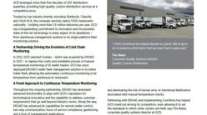Truckload Fleets Shifting Driver Pay to Emphasize Performance
This story appears in the March 4 print edition of Transport Topics.
Truckload fleets increasingly are tying pay increases to driver performance, instead of giving across-the-board raises, according to industry experts and carrier executives.
That’s a tactical shift for carriers that have been pressured to raise pay over the past three years as freight volumes have increased, said Gordon Klemp, president of the National Transportation Institute, which compiles pay and benefits data from 300 truckload fleets.
“The custom in the industry has been to raise pay as needed, due to the necessity to fill seats,” Klemp told Transport Topics on Feb. 26. “Company driver pay increases have slowed down almost to nil. The uncertainty in the marketplace made people at carriers nervous about locking themselves into pay increases.”
Post-recession pay increases have been pegged at 5% to 10%, or about 2 cents to 4 cents per mile annually, in surveys by Klemp and others, such as Transport Capital Partners.
Werner Enterprises has moved away from automatic increases, said Derek Leathers, president and chief operating officer, whose company has more than 220 different pay package variables.
“The days of across-the-board pay raises are over,” he said at an investor conference last month. “Most of the fleet didn’t get a raise last year because the pay is fair and turnover isn’t getting worse.”
Werner ranks No. 11 on the TT Top 100 list of the largest for-hire carriers in the United States and Canada.
“This trend toward more variable pay gives the opportunity for the driver to increase pay by achieving benchmarks that are connected to improving the profit and efficiency of the carrier,” said Klemp. “These steps are all designed to lock the interests of the carrier and the driver together.”
The benchmarks measure factors such as safety, roadside inspections and equipment utilization measured by loaded miles run, and performance pay increases typically are up to 2 cents per mile, Klemp said.
Fleet officials confirmed the changing market.
“We have not done an across-the-board wage increase,” Shepard Dunn, CEO of Bestway Express, told TT. “We just rolled out a new fuel bonus program that pays an additional 2.5 cents per mile for over-the-road drivers. Instead of giving the drivers an across-the-board increase with nothing in return, we tied the dollars to something we could measure.”
“We’ve never had a fuel bonus program that really worked, primarily because we were not hooked into the electronic control module of the tractors,” he said. “After moving recently to a new
mobile communication platform, PeopleNet, we now are getting that data, which has driven us to adding the fuel bonus program.”
“We didn’t change driver pay last quarter,” said Chip Smith, chief operating officer at Bay & Bay Transfer Co., told TT. “The situation seems to be fairly status quo.”
“We are just trying to match demand to capacity that we have now,” Smith said. “We aren’t planning to add a huge amount of capacity.”
Bay & Bay is making changes elsewhere, Smith said, to boost its recruiting staff after the company’s 2012 experience.
Recruiters reviewed 50,000 driver applications last year, but just 300, or less than 1%, were hired, he said, leaving turnover for the 450-truck fleet below the industry average.
The few pay increases that were given to company drivers last year came from fleets in the bottom half of the pay survey and ranged from 1 cent to 2 cents per mile, Klemp said.
Owner-operator pay kept rising last year, at about 2 cents to 2.5 cents per mile, Klemp said; those drivers have more leverage because they’re scarcer.
The new approach has broken the pattern of automatic pay increases based on tenure and has made adjustments more frequently based on progress reports issued as often as weekly.
Driver supply “is right at the equilibrium point,” just like freight demand, Leathers said. “That’s the razor’s edge we’re on.”
But the situation may change. “There isn’t any slack in the freight system today,” said Steve Prelipp, a consultant on driver issues. “This may well be the lull before the storm.”
“My guess is that, sometime in 2013, people are going to have to move pay up once demand gets better, as the dollars that are sitting on the sidelines get invested in a growing economy,” he said.
Pay increases typically follow increasing demand, which may come later this year, said Prelipp, a former executive at Schneider National.
He also said that truckload fleets increasingly are relying on “finishing training” to instruct driving school graduates and lease-purchase programs to retain drivers.
Drivers care about things besides pay, Leathers and others said, such as home time and new equipment.
“In talking with many other fleet owners, I’m convinced the driver shortage is not exclusively due to wages, although that is part of it,” Dunn said. “I know many fleets that pay far more than we do, and they can’t get drivers either.”
The bigger issue for drivers is, “Do you have freight where they want to run?” Smith said.



